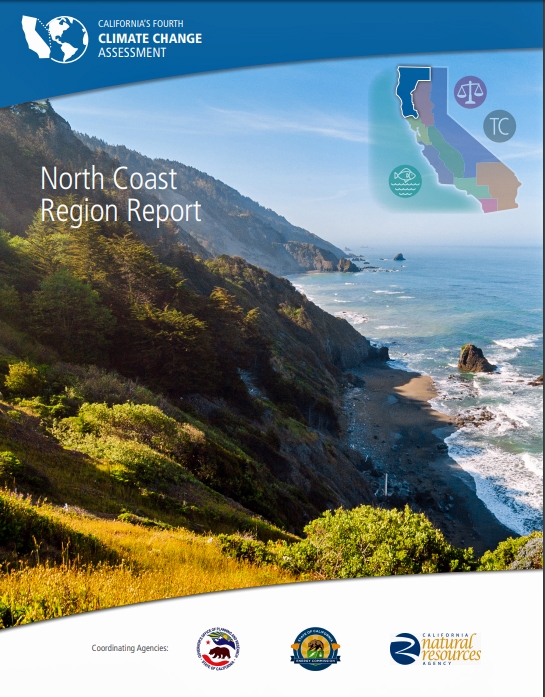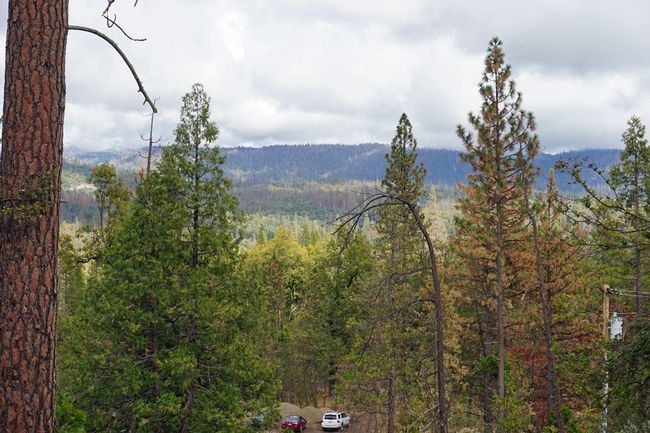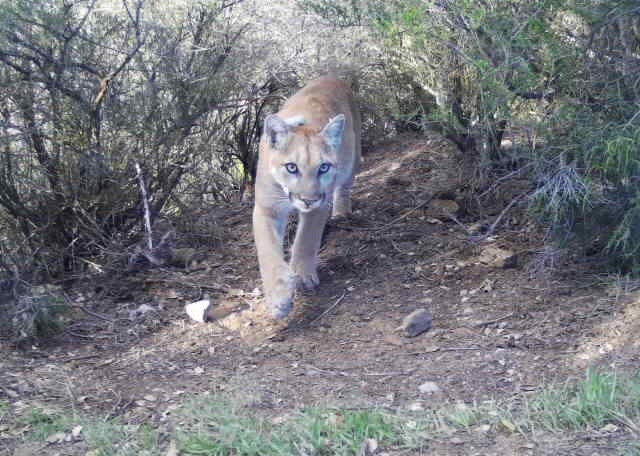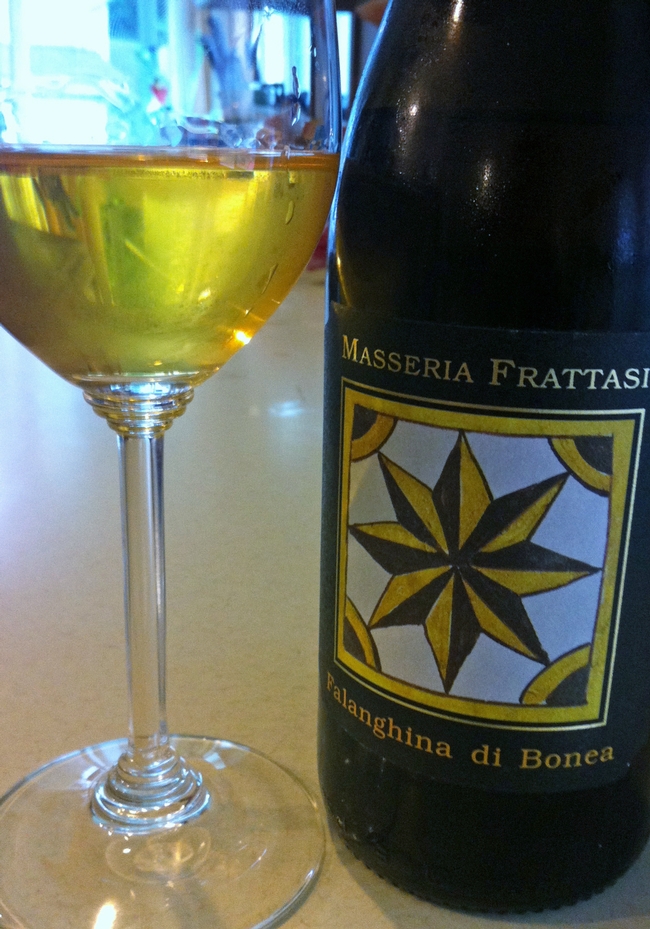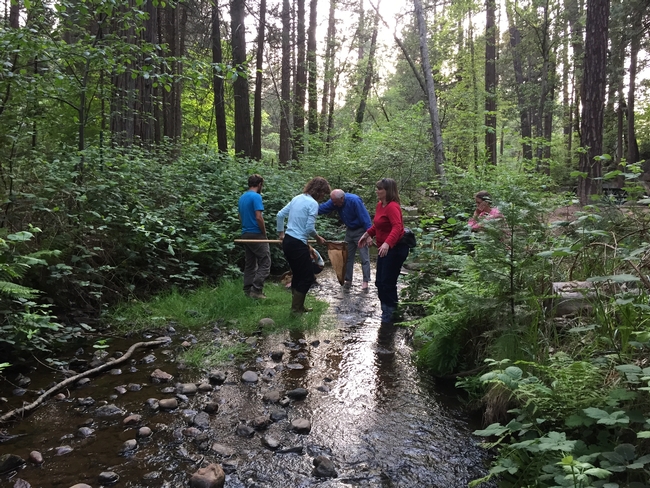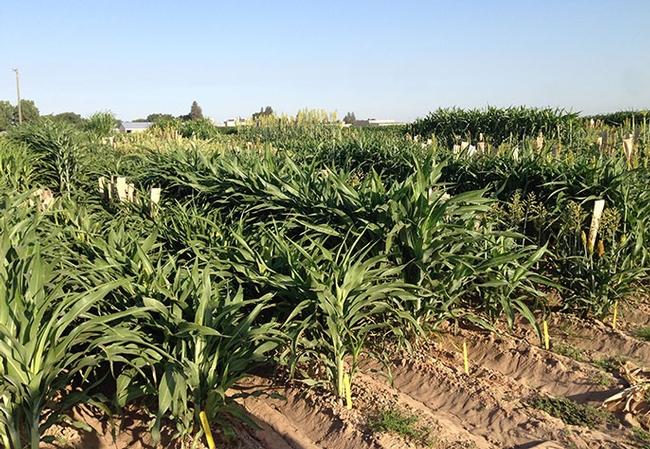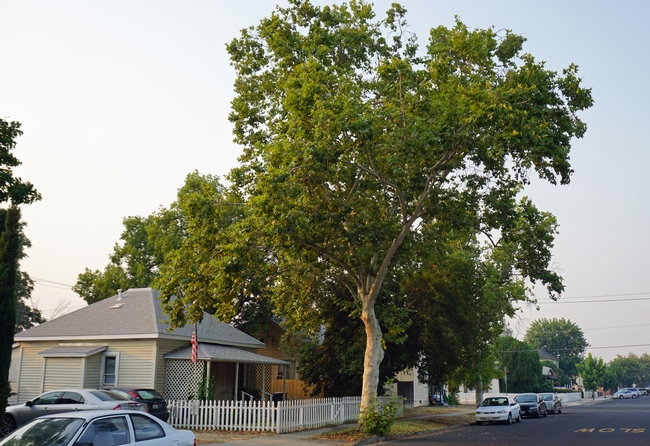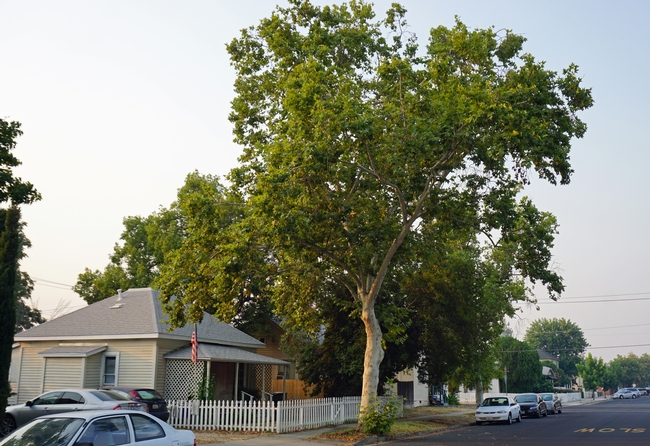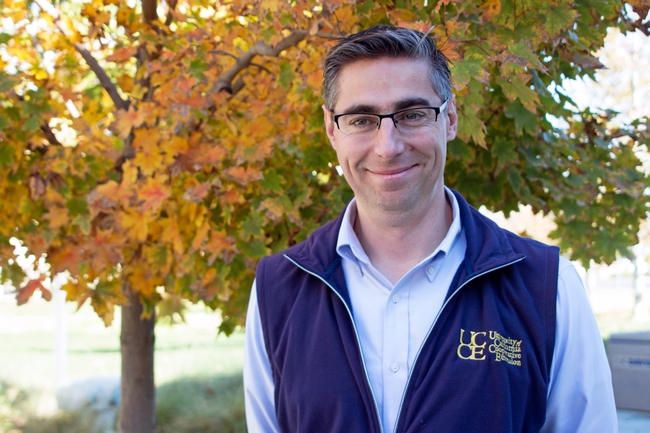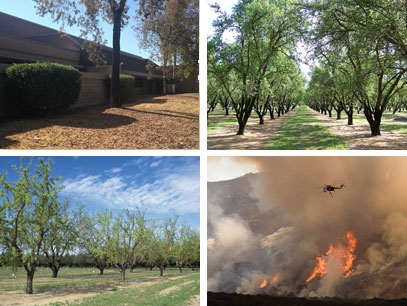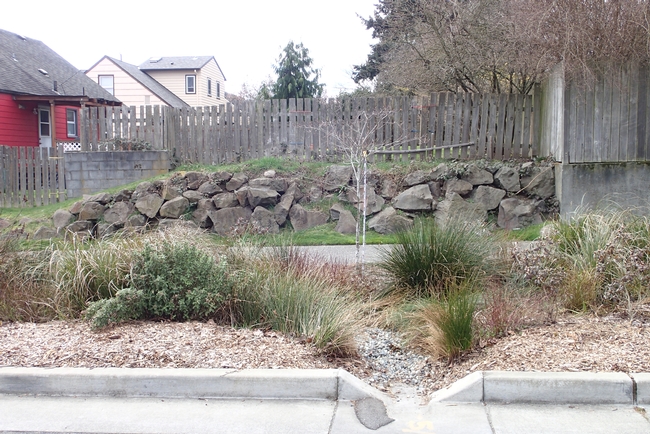Posts Tagged: Igor Lacan
UC Cooperative Extension works in local communities to help Californians adapt to climate change
Californians received bleak news last month when the state released its fourth assessment of climate change in California. The report predicts severe wildfires, more frequent and longer droughts, rising sea levels, increased flooding, coastal erosion and extreme heat.
“It's great to be living in a state where science and facts around climate change are valued,” said UC Cooperative Extension specialist Adina Merenlender, “but the recent forecasts may make you want to devour a quart of ice cream in a pool of salty tears.”
Modern civilization has changed the world climate, and even dramatic reductions in global greenhouse gas emissions at this point won't turn back the clock. The warming now predicted by Cal-Adapt is likely already “baked in,” even with our best mitigation efforts, said Igor Lacan, UC Cooperative Extension advisor in the Bay Area of California.
California has been a leader in facing the future climate head on. The state's first comprehensive assessment on climate change was produced in 2006 under then-Gov. Arnold Schwarzenegger. The second assessment, released in 2009, concluded that adaptation could reduce economic impacts of loss and damage from a changing climate. The third assessment was shaped by a request for more information on the adaptation options in the 2009 report. The fourth assessment was the first effort to break down global climate predictions and their impacts onto specific regions of California.
Author of the North Coast Region Report of the Fourth Assessment, Ted Grantham, praised state leaders for pushing forward efforts to slow climate change and adapt to the new weather conditions expected in California.
“California is playing a unique role in filling the void of leadership on this issue that the federal government was beginning to address under the Obama administration,” Grantham, a UC Cooperative Extension specialist based at UC Berkeley, said.
Across California, UC Cooperative Extension specialists and advisors are working in their local communities to prepare for warming temperatures and adapt to the changing climate. Following are examples of the efforts now underway.
Managing forests to survive the future
Among the suggested adaptation strategies in the 81-page North Coast Region Report, written by Grantham and his colleagues, the authors encourage government agencies and private forest owners to use prescribed fires and active forest management to reduce an overgrowth of trees and shrubs that fuel the more frequent and intense fires expected in the future.
Although climate change will create conditions conducive to catastrophic wildfire, the reason for dangerous forest overgrowth is related to decades of fire suppression on the landscape.
“Our forests are much denser and have more fuel buildup than they would have under a natural fire regime,” Grantham said. “Mechanical thinning, removing wood from the landscape and prescribed fires can help limit the impacts of wildfire.”
Native American tribes are being tapped to share their traditional ecological knowledge to inform this practice.
“Native Americans have used fire since time immemorial to manage their landscapes,” Grantham said.
Connecting habitats to allow species movement
When climate changes, plant and animal species may find their current habitats no longer fit the environment where they evolved. The fourth assessment technical report, Climate-wise Landscape Connectivity: Why, How and What Next, written by UCCE specialist Adina Merenlender, documented potential techniques to erase barriers to plant and animal movement.
“When we talk about wildlife corridors today, we might view a road as a barrier,” Merenlender said. “With climate change, the movement is over a much longer range for species to find suitable habitat at the end of the century.”
The report says research is needed to compare different approaches to designing climate-wise connectivity, determining how wide corridors need to be, and quantifying the impact of natural and anthropogenic barriers on possible range shifts.
California's wine industry is based on international varieties that come from Northern France, where the climate is cool, mild and consistent.
“They really require a cool to warm climate, not a hot climate,” said Glenn McGourty, UCCE viticulture advisor in Mendocino County.
There are many wine grape cultivars from Southern Europe – areas in Italy, Portugal and Spain – that are adapted to heat and make quality wines, but aren't well known. The varieties include Monepulciano, Sagrantino, Periquita and Graciano.
McGourty is studying how these cultivars perform in the warm interior of Mendocino County at the UC Hopland Research and Extension Center.
“We have many options as climates warm in the interior part of California to make wine that needs less amelioration in the winery compared to cultivars from Northern France,” McGourty said.
Recruiting and training climate stewards
The UC California Naturalist Program is moving full steam ahead with a new Climate Stewards Initiative to build engaged communities and functioning ecosystems that are resilient to changing climates.
California Naturalist, with trained volunteers across the state working with myriad conservation organizations, will be using its educational network to improve the public's understanding of climate change and engage the public in community action and local conservation.
“Climate stewards will offer in-person communication with your neighbors, tapping into science,” Merenlender said. “Improving climate literacy is an important outcome, but that won't happen through a website.”
Helping growers modify farming practices due to changing climate
USDA Climate Hub has awarded a grant to UC Cooperative Extension to support tools to assist growers in making strategic decisions in season and long term.
“We have many credible sources of weather and climate data, but often times we are challenged with translating it into decision support tools tailored to growers' needs,” said Tapan Pathak, UCCE specialist in climate change adaptation in agriculture. “It's too early to say which specific tools we will develop, but we are aiming to help farmers use weather and climate information in decision making processes.”
Pathak is also working with colleagues to analyze how generations of navel orangeworm, a significant almond pest, might shift for the entire Central Valley under climate change and how growers can adapt their practices to manage the higher pest pressure.
Using epigenetics to impart drought tolerance
At the UC Kearney Agricultural Research and Extension Center in Parlier and the UC West Side Research and Extension Center in Five Points, sorghum nurseries are being grown under drought and well-watered conditions to compare the environmental impacts on the plants' gene expression.
“We hope to tease out the genetics of drought tolerance in sorghum,” said Jeff Dahlberg, UCCE specialist, who is managing the trials at Kearney. “Using sorghum as a model, we expect this research to help us understand drought tolerance in other crops as well.”
Historically, the genetic manipulation of crops, which has been critical to increasing agricultural productivity, has concentrated on altering the plant's genetic sequence, encoded in its DNA.
Recent studies have shown that environmental stresses – such as drought – can lead to epigenetic changes in a plant's genetic information. Because epigenetic changes occur without altering the underlying DNA sequence, they allow plants to respond to a changing environment more quickly.
Cities can plant street tree species suited to future climate
Many common street trees now growing in the interior of California are unlikely to persist in the warmer climate expected in 2099, according to research published in the July 2018 issue of the journal Urban Forestry & Urban Greening. (Read the research report here until Sept. 27, 2018)
“Urban foresters in inland cities of California should begin reconsidering their palettes of common street trees to prepare for warmer conditions expected in 2099 due to climate change,” said the study's co-author, Igor Lacan, UC Cooperative Extension environmental horticulture advisor in the Bay Area.
Common trees in Coastal California cities appear to be better suited to withstand the 2099 climate.
“Our research shows that some trees now lining the streets of cities like Fresno, Stockton and Ukiah are likely to perform poorly in 2099,” Lacan said. “Those cities need to look at the conditions – and trees – now found in El Centro, Barstow and Fresno respectively.”
Trees to shade California in a warmer future
The changing climate predicted for California – including less rain and higher day and nighttime temperatures – is expected to cause chronic stress on many street tree species that have shaded and beautified urban areas for decades.
Realizing that popular trees may not thrive under the changing conditions, UC Cooperative Extension scientists are partnering with the U.S. Forest Service in a 20-year research study to expand the palette of drought-adapted, climate-ready trees for several of the state's climate zones.
“The idea is to look at available but under-planted, drought-tolerant, structurally sound, pest resistant trees for Southern California that do well in even warmer climates,” said Janet Hartin, UCCE horticulture advisor in San Bernardino County.
Twelve tree species were selected for each climate zone in the comparative study, with several area parks used as control sites.
Managing the forest for survival in warmer conditions
UC Cooperative Extension scientists are part of a collaborative research project with the University of Nevada, Reno, CAL FIRE and the U.S. Forest Service aimed at developing new strategies to adapt future forests to a range of possible climate change scenarios in the Sierra Nevada.
“It includes the idea that we may be struggling just to keep forests as forests, let alone having the species we value,” said Rob York, manager of UC Berkeley's Blodgett Forest Research Station near Georgetown.
Forests sequester a tremendous amount of carbon. As the climate changes, foresters will need to be proactive to reduce the risk of these massive carbon sinks becoming carbon sources.
“We're working to mitigate predicted impacts to forests, including regeneration failures, drought mortality and catastrophic wildfire,” Ricky Satomi, UCCE natural resources advisor in Shasta County.
At three separate study sites across the Sierra Nevada, novel approaches to forest management are being implemented to develop treatments that scientists believe will increase resilience, resistance and adaptability of Sierra Nevada mixed conifer forests.
The 2018-21 project is led by Sarah Bisbing, forest ecology professor at the University of Nevada, Reno, and funded with $2.7 million from CAL FIRE.
Climate change impacts on vulnerable communities
The latest climate assessment also reports on the serious nature of climate threats to vulnerable communities and tribal communities in California, with a focus on working collaboratively with these communities on research and solutions for resilience.
“The impacts of climate change will not be experienced equally among the population,” Grantham said. “The most significant public health and economic impacts – from flooding, extreme heat, air quality degradation, etc. – will be disproportionately experienced by vulnerable populations, including people of color, the poor and the elderly.”
The assessment includes a Climate Justice Report, which shares the idea that no group of people should disproportionately bear the burden of climate impacts or the costs of mitigation and adaptation. The report suggests collaborating with these communities on research and solutions for resilience.
August 2018 News Clips 8/1-8/15
UC: Tariffs could cost fruit, nut industries over $3 billion
(Farm Press) Aug. 15
A new report released by the University of California Agriculture and Natural Resources' Agricultural Issues Center estimates the higher tariffs could cost major U.S. fruit and nut industries $2.64 billion per year in exports to countries imposing the higher tariffs, and as much as $3.34 billion by reducing prices in alternative markets.
https://www.westernfarmpress.com/tree-nuts/uc-tariffs-could-cost-fruit-nut-industries-over-3-billion
Evacuation priorities: Save people first, then livestock
(Ag Alert) Kathy Coatney, Aug. 15
"It's generally too difficult to get trucks out on such a short notice," said Glenn Nader, University of California Cooperative Extension livestock and natural resources advisor emeritus for Butte, Sutter and Yuba counties.
… Carissa Koopmann Rivers, UCCE livestock and natural resources advisor for Siskiyou County, said the Klamathon fire, first reported in early July, devastated the town of Hornbrook, which is situated in a cattle-producing area.
…Ricky Satomi, UCCE forestry advisor for Shasta, Trinity and Siskiyou counties, said if there's a wildfire and a person has advanced notice, there are several things that can be done to save buildings before evacuating.
http://agalert.com/story/?id=12106
Tariffs Could Cost California Growers Billions
(Growing Produce) Christina Herrick, Aug. 15
A new study from the University of California Agriculture and Natural Resources' Agricultural Issues Center finds that tariffs on 10 fruit and tree nut exports alone are estimated to cost the U.S. $3.4 billion annually.
https://www.growingproduce.com/nuts/tariffs-cost-california-growers-billions/
Interior Secretary: Environmental policies, poor forest management to blame for wildfires
(Circa) Leandra Bernstein, Aug. 14
…"Together, poor land management, poor land use planning and the onset of climate change, we have created the perfect environment for the perfect firestorm in California. It's completely expected and it's going to get worse," explained Dr. Kate Wilkin, a fire scientist at the University of California Cooperative Extension.
Looming Chlorpyrifos Ban Has ‘Natural' Pesticide Makers Buzzing
(Bloomberg) Tiffany Stecker, Aug. 14
...Alternatives may be available, but they lack the punch of chlorpyrifos, which kills multiple pests at once, Beth Grafton-Cardwell, a scientist working with citrus farmers as part of the University of California Cooperative Extension, told Bloomberg Environment.
https://www.bna.com/looming-chlorpyrifos-ban-n73014481691/
Fierce and Unpredictable: How Wildfires Became Infernos
(New York Times) Jim Robbins, Aug. 13
…Triple-digit temperatures “preheat the fuels, and it makes them much more receptive to igniting,” said Scott L. Stephens, a fire ecologist at the University of California, Berkeley.
https://www.nytimes.com/2018/08/13/science/wildfires-physics.html
In California's new wildfire reality, facing the need for periodic fires to clear fuel
(SF Chronicle) Kurtis Alexander, Aug. 13
While misguided forest- management policies are just one reason that fire has become more devastating, a warming climate and more development in California's wildlands also contribute, making planned burning vital, said wildfire specialist Max Moritz with UC's Division of Agriculture and Natural Resources.
“We need to become more comfortable with fire as a tool,” he said. “Prescribed fire could do a lot of good, restoring these forests to healthy conditions and reducing the fire hazard.”
8/13/18 Trade Tensions
(NewsTalk 780 KOH) Jon Sanchez Show, Aug. 13
Daniel Sumner, director of the UC Agriculture Issues Center, discussed the impact of trade tariffs on agriculture and U.S. economy with Jon Sanchez
https://www.spreaker.com/user/10565136/sanchez0813
UCCE Manure Nitrogen Study Update in Dairy Feed Crops
(California Dairy Magazine) Aug. 10
It takes time for the nitrogen found in dairy manure water to become available to feed crops out in the field, and as dairy producers don't want to under or over fertilize their feed crops, the UC Cooperative Extension is conducting a research trial to find out more regarding how manure water interacts in the soil with plant root systems. Watch this brief interview UC Agronomy Advisor Nicholas Clark as he summarizes a recent presentation he shared at the Golden State Dairy Management Conference.
Trees vital as heat waves ravage Southland, experts and L.A. officials say
(Hub LA) Hugo Guzman, Aug. 10
…Researchers with the University of California Cooperative Extension are helping do just that. In partnership with the United States Forest Service, researchers there have launched a 20-year study to identify trees that can withstand higher temperatures and lower rainfall. Native trees such as the Catalina Cherry and Ironwood trees, along with imports like Ghost Gum and Acacia trees, could form the future of L.A.'s canopy.
http://www.hub-la.com/news/trees-heat-waves-ravage-southland-officials/
Elkus Ranch brings kids to nature
(Half Moon Bay Review) Max Paik, Aug. 8
“I think it's important that the children get to see what it takes to care for farm animals … from the cute to the somewhat smelly,” said Igor Lacan, environmental horticulture adviser with the University of California Cooperative Extension, which runs the ranch.
What These Wildfires Say About Climate Change
(OnPoint NPR) Eric Westervelt, Aug. 8
Guests
- Daniel Berlant, assistant deputy director of Cal Fire, the state's fire agency.
- Ryan Lillis, reporter for the Sacramento Bee. He has covered most of Northern California's fires for the last 12 years. (@Ryan_Lillis)
- Lenya Quinn-Davidson, area fire adviser with the University of California's Cooperative Extension, which works with counties and communities in the state on managing the threat of wildfires. Northern California coordinator of the California Fire Science Consortium. (@lenyaqd)
Michael Mann, professor of atmospheric science and director of the Earth System Science Center at
Pennsylvania State University. Co-author of "The Madhouse Effect: How Climate Change Denial is Threatening Our Planet, Destroying Our Politics, and Driving Us Crazy." (@MichaelEMann)
http://www.wbur.org/onpoint/2018/08/08/mendocino-complex-wildfires-california-climate-change
Drought may be increasing camel cricket numbers
(Farm Press) Tim Hearden, Aug. 8
A few years ago, University of California viticulture and pest management advisors noticed unusual leaf symptoms in certain Napa County hillside vineyards that were right next to oak woodlands.
As described by the UC Cooperative Extension's Monica Cooper and Lucia Varela, the feeding activity they noted in April 2015 resulted in a “lace-like” appearance to damaged leaves. Then last year, in March, they observed feeding damage to expanding buds.
… Where vineyards have come into play is when they were situated on hillsides next to oak woodlands and mixed species of white alders, madrone, California bay, and Douglas fir, according to Varela, a north coast integrated pest management advisor, and Rhonda Smith, a UCCE viticulture advisor.
https://www.westernfarmpress.com/grapes/drought-may-be-increasing-camel-cricket-numbers
Yes, humans have made wildfires like the Carr fire worse. Here's how.
(Washington Post) Sarah Kaplan, Aug. 8
…Many forests in the western United States are “fire adapted” said Scott Stephens, a fire ecologist at the University of California at Berkeley. Natural wildfires every 5, 10 or 20 years help clear debris from the forest floor and make room for stronger, healthier trees.
…Wildfires are as unstoppable as hurricanes, Stephens said — and much like hurricanes, increasingly inevitable as the climate changes. “But you could do a lot more when you're getting ready for fire to inevitably occur,” he said. By building with fire-safe materials, establishing buffer zones between ecosystems and communities, and better caring for forests before fire season starts, some of the destructiveness of fires could be mitigated, Stephens said.
The staggering scale of California's wildfires
(New York Times) Lisa Friedman, Jose A. Del Real, Aug. 8
…Lisa: Mr. Trump in his tweet referred to the longstanding dispute between California farmers and environmentalists over the allocation of the state's precious water resources. Both sides want more and Mr. Trump has embraced the arguments of the agriculture community.
But William Stewart, a forestry specialist at the University of California, Berkeley said leaving less water for fish would have no impact on amount available for fighting fires. That water comes from local streams and rivers, where water-dropping helicopters drop their buckets. Neither he nor other scientists could point to a scenario in which California's environmental laws have prevented or curbed the use of water to fight wildfires.
https://www.nytimes.com/2018/08/08/us/california-today-fires-and-climate.html
California giving out $170 million in cap-and-trade revenue to help prevent wildfires
(San Francisco Chronicle) Kimberly Veklerov, Aug. 8
…Groups in six Bay Area counties will get a combined $7.4 million. The biggest portion of that, $3.6 million, will go to UC Berkeley. The Federal Emergency Management Agency in 2016 withdrew what would have been an award of roughly the same amount to thin and remove eucalyptus trees in the East Bay hills after a lawsuit by conservation activists.
…Keith Gilless, chairman of Cal Fire, said the state needs to do much more vegetation management — activities like reducing hazardous plant fuels — to address wildfire risk.
“One of the things we need in California moving forward is striking a better balance between carbon sequestration in forests and the risk associated with that densely stocked carbon sequestration,” said Gilless, also a UC Berkeley professor of forest economics. “We need to figure out ways to do vegetation management that are socially acceptable with the smallest public subsidy possible.”
These California counties have the highest concentration of homes vulnerable to wildfire
(Sac Bee) Michael Finch II, Aug. 7
In the case of the northern counties, the risk will be higher because homes there often dispersed at the edge of a wildland area, said Lenya Quinn-Davidson, a Eureka-based fire advisor for the University of California Division of Agriculture and Natural Resources.
“Those areas that you mentioned are areas that have a lot of homes mixed into the wildland-urban interface — areas where there are a lot of homes that are edgy and in the forest and have a lot of fuel.”
https://www.sacbee.com/news/state/california/fires/article216076320.html#storylink=cpy
Can More Logging Help Prevent California Wildfires?
(KQED) Forum, Aug. 7
Cal Fire officials announced yesterday that the Mendocino Complex fire grew to over 283,000 acres, making it the largest in state history. As wildfires across the state rage on, Governor Brown and some lawmakers are calling for increased forest thinning to lessen the threat posed by fires. Those in favor of logging say that removing trees and vegetation can help reduce a fire's intensity and make forests more resilient. Opponents say thinning does nothing to protect communities from fires and imperils species that depend on dense forests. We'll take up the debate.
Guests:
Chad Hanson, director, John Muir Project of Earth Island Institute ; co-author, "Nature's Phoenix: The Ecological Importance of Mixed-Severity Fires"
Molly Peterson, reporter on assignment for KQED News
Scott Stephens, professor of fire science at the College of Natural Resources, UC Berkeley
Rich Gordon, president and CEO, California Forestry Association, former assemblymember representing California's 21st district
Jim Wood, assemblymember for district 2, Sonoma County, a member of the Senate and Assembly conference committee on wildfire preparedness and response
https://www.kqed.org/forum/2010101866607/can-more-logging-help-prevent-california-wildfires
Trump wants to clear more trees to halt fires. The feds need to spend more, experts say.
(Sac Bee) Emily Cadei and Kate Irby, Aug. 7
“I think for a number of years the feds were more ahead of this dilemma, at least in discussions,” said Scott Stephens, a professor of fire science at the University of California, Berkeley. But “I have to say right now, I think the state is moving ahead. It's certainly being more innovative, it's doing more policy work.”
https://www.sacbee.com/news/politics-government/capitol-alert/article216160995.html
Trump says California's water policies are making the wildfires worse. Is he right?
(Sac Bee) Dale Kasler, Aug. 6
William Stewart, a forestry management expert at UC Cooperative Extension, agreed. “The entity that's doing the worst job are the people working for him,” Stewart said, referring to Trump.
Stewart said the Carr Fire, which killed seven people and forced mass evacuations in and around Redding, started in shrub and grasslands west of the city, not in the forests. Only lately, after the threat to Redding abated, has the fire moved north onto Forest Service land and forested property owned by Sierra Pacific Industries, he said.
https://www.sacbee.com/news/politics-government/capitol-alert/article216181625.html
California Groundwater Law Means Big Changes Above Ground, Too
(Water Deeply) Matt Weiser, Aug. 6
The best groundwater recharge areas have certain soil types that are good at absorbing water. These areas have already been mapped by, among others, the California Soil Resource Lab at the University of California, Davis. [Tobi o'Geen's lab]
Cal Fire responds to President Trump's tweet about state wildfires
(ABC7) Rob McMillan, Aug. 6
Cal Fire and a researcher from UC Riverside responded to Donald Trump's tweet related to the state's wildfires on Monday.
"Thinning would be a good idea, but the question is how you thin properly," UC Riverside's Dr. Richard Minnich said.
"There are too many trees in the ground sucking the ground dry. That's one of the reasons you had so many trees die in the Sierras."
But Minnich says that there is plenty of water in California. Shasta is the biggest reservoir in the state and it's currently more than two-thirds full.
https://abc7.com/politics/cal-fire-responds-to-president-trumps-tweet-/3896820/
California Wildfires: It's a people problem
(East Bay Times) Lisa Krieger, Aug. 5
Even as fires rage across California, thousands of new homes are being built deeper into our flammable foothills and forests, as lethal as they are lovely.
A big reason why: It's harder to do controlled burns — one of the most effective fire suppression techniques — near residential areas, due to smoke concerns. Until the 1970's, fire suppression tended to minimize fire spread.
“If homes are sprinkled through the landscape, you take that key tool off the table,” said Max Moritz, a wildfire specialist with UC's Division of Agriculture & Natural Resources.
https://www.eastbaytimes.com/2018/08/05/california-wildfires-its-a-people-problem/
Report: Future climate could affect street trees
(Turlock Journal) Kristina Hacker, Aug. 3
Eighty-one years from now, Turlock's climate could resemble more of southeast California's high desert areas, according to a new report that says inland California municipalities should consider increasing temperatures due to climate change when planting street trees.
…"Urban foresters in inland cities of California should begin reconsidering their palettes of common street trees to prepare for warmer conditions expected in 2099 due to climate change," said the study's co-author, Igor Lacan, UC Cooperative Extension environmental horticulture advisor in the Bay Area.
https://www.turlockjournal.com/news/local/report-future-climate-could-affect-street-trees/
Wildfires force California to reckon with a not-so-new normal
(Christian Science Monitor) Martin Kuz, Aug. 3
…The committee's focus on improving utility grid safety and examining the liability of power companies reflects the causes of several blazes in 2017. The absence of land use planning from its agenda suggests what Max Moritz, a wildfire specialist at the University of California, Santa Barbara, describes as a “political will problem.”
“If you want to keep communities safe, then you have to think about living differently, about where and how we build our communities,” he says. “But there's no bill in the legislature about that.”
Will smoke taint summer harvests in the Mother Lode?
(The Union Democrat) Giuseppe Ricapito, Aug. 3
Drift smoke from the Ferguson Fire has some Tuolumne County vintners and agriculturalists concerned about the commercial viability of the early fall grape harvest, but one forestry official with the University of California noted that the native wilderness of the Mother Lode has a developed adaptability to smoky conditions.
Susie Kocher, forestry and natural resources advisor with the University of California Department of Agriculture and Natural Resources Central Sierra Cooperative Extension, said that “smoke taint” of commercial agriculture was always a concern during fire season.
“It's grapes we worry about the most,” she said. “In the past there have been bad years when there was a lot of smoke where grapes were on the vine and wineries had to produce the smoky wine because of that effect.”
https://www.uniondemocrat.com/localnews/6425094-151/will-smoke-taint-summer-harvests-in-the-mother
Coyote encounters expected to rise during heat and drought
(ABC 10) Jared Aarons, Allison Horn, Aug. 2
The record-breaking heat and drought are forcing animals, including coyotes, out of their natural habitats and closer to humans…
The University of California Coyote Catcher website tracks sightings and attacks. Their figures for 2018 show coyote incidents are down compared to last year. In 2017, there were 142 coyote attacks. More than halfway through 2018, San Diego is on track to stay below that number, with 64 attacks.
According to the website, there have been six reported pet deaths this year.
https://www.10news.com/news/coyote-encounters-expected-to-rise-during-heat-and-drought
Backyard chickens are dying in droves in SoCal. Will disease spread to Valley?
(Fresno Bee) Robert Rodriguez, Aug. 2
Maurice Pitesky, a veterinarian and University of California extension specialist in the School of Veterinary Medicine at UC Davis, said backyard chicken owners should closely watch their flocks.
Symptoms include, sneezing, coughing, green watery diarrhea, neck twisting, paralysis, decreased egg production and swelling around the eyes and neck.
https://www.fresnobee.com/news/business/agriculture/article215859875.html
Growers prepare for smaller prune harvest
(Farm Press) Tim Hearden, Aug 2
…With guidance from University of California Cooperative Extension advisors, growers have been paying close attention to tree water stress and sugar levels in the weeks leading up to the harvest, which was expected to begin in about the third week of August.
… “It's probably going to vary a little bit because the cropping is really variable,” UCCE advisor emeritus Rick Buchner says of the prune crop. “Some of it is good and some is really light. We had a heck of a time pollinating them.”
…“Harvest can be a nerve-wracking time in the prune business,” UCCE advisors Franz Niederholzer and Wilbur Reil note in a California Dried Plum Board blog post. “The finish line – when the entire crop is in the bins – may be in sight, but here are still tough decisions to be made that influence your bottom line.”
…In general, harvest can be expected roughly 30 days after the first healthy fruit in an orchard starts changing color, UCCE orchard advisor Katherine Jarvis-Shean explains in a separate blog post. She urged growers to time their irrigation cut-off to improve dry-away ratios, reduce premature fruit drop and decrease shaker bark damage at harvest.
https://www.westernfarmpress.com/orchard-crops/growers-prepare-smaller-prune-harvest
Researchers look at ways to improve onion yields
(Ag Alert) Padma Nagappan, Aug. 1
Jairo Diaz-Ramirez and five other scientists have recently completed year two of an irrigation trial for onions, testing furrow and drip irrigation, and found that their methods produced good results, without water distress or soil tension. They tested the Taipan variety of onions.
http://agalert.com/story/Default.aspx?id=12068
Cities in California inland areas must make street tree changes to adapt to future climate
Many common street trees now growing in the interior of California are unlikely to persist in the warmer climate expected in 2099, according to research published in the July 2018 issue of the journal Urban Forestry & Urban Greening.
“Urban foresters in inland cities of California should begin reconsidering their palettes of common street trees to prepare for warmer conditions expected in 2099 due to climate change,” said the study's co-author, Igor Lacan, UC Cooperative Extension environmental horticulture advisor in the Bay Area.
Common trees in Coastal California cities appear to be better suited to withstand the 2099 climate.
“Our research shows that some trees now lining the streets of cities like Fresno, Stockton and Ukiah are likely to perform poorly in 2099,” Lacan said. “Those cities need to look at the conditions – and trees – now found in El Centro, Barstow and Fresno respectively.”
To reach these conclusions, Lacan and co-author, professor Joe McBride of UC Berkeley, used space-for-time substitution. They compared the most common street tree species in cities representing each of the 16 California climate zones with trees in cities that currently have climates that approximate the expected warmer conditions in the 16 cities 80 years from now.
For example, Eureka can expect a climate like Berkeley's today; Fresno's climate will resemble the climate of El Centro today. (Find the complete list of cities below.) The corresponding cities were determined with climate predictions from Cal-Adapt, which synthesizes California climate change scenarios to reach a consensus view of the magnitude of climatic warming.
“We used the mid-range models,” Lacan said. “It's very reasonable to say the warming predicted by the model we used is already ‘baked in,' regardless of any mitigation efforts. While we should take measures to prevent even greater warming – mostly by reducing the use of fossil fuels – this study aims to help adapt California urban forests to the warming that can be reasonably expected to occur.”
Lacan said he and McBride were surprised to find that coastal cities and their warm equivalents contain most of the same common urban tree species, while the warm equivalents of inland cities seemed to lack most and, in some cases, all of the common trees there today.
“It's really a sharp distinction,” Lacan said. “Perhaps they were lucky, but coastal cities are better positioned for the climate of 2099 than the inland cities.”
|
Climate zone |
City |
Corresponding city |
|
1 |
Eureka |
Berkeley |
|
2 |
Ukiah |
Fresno |
|
3 |
Berkeley |
Santa Ana |
|
4 |
King City |
Stockton |
|
5 |
Santa Maria |
Santa Ana |
|
6 |
Santa Monica |
King City |
|
7 |
San Diego |
Santa Ana |
|
8 |
Santa Ana |
Burbank |
|
9 |
Burbank |
Fresno |
|
10 |
Riverside |
Barstow |
|
11 |
Yuba City |
El Centro |
|
12 |
Stockton |
Barstow |
|
13 |
Fresno |
El Centro |
|
14 |
Barstow |
El Centro |
|
15 |
El Centro |
Furnace Creek |
|
16 |
Susanville |
Barstow |
For a copy of the complete research report email Igor Lacan, ilacan@ucanr.edu.
Media reaches out to UC ANR for drought news
As the California drought wears on, media have reached out this week to UC Agriculture and Natural Resources advisors about consequences in agricultural cropland, urban landscapes and fire-prone wildland.
Agricultural cropland
NPR's Valley Public Radio ran a story about salt buildup in almond orchards. Without rainfall to move salts below almond trees' rootzone, harmful levels of salinity are building up in the soil. “We've been seeing this increasing problem over the past couple years, due to the lack of winter rain, of sodium burn or salt burn on leaves," said UC ANR Cooperative Extension farm advisor David Doll. “Rain will do it (leach salts) naturally for us, but if we don't get rain we've been encouraging farmers to actually fill the profile with irrigation water, whatever they can by December. And then hopefully whatever rain we do get will help aid with the flushing of the root system of the tree.”
KCOY,KEYT andKKFX TV in Santa Maria ran a story on new technologies being used by a local strawberry farmer to irrigate efficiently. The farmer installed microsprinklers and moisture sensors on his strawberry field to monitor water and fertilizer inputs. Mark Gaskell, UC ANR Cooperative Extension farm advisor, developed the technology. "By identifying and carefully documenting how much water or nutrients are lost or how much variation there is, a grower can modify their management so that they can be more efficient when applying water," Gaskell said.
Urban landscapes
KQED Science posted an eight-minute interview with UCANR Cooperative Extension urban forestry advisor Igor Lacan. He explained how to irrigate young and mature trees so they won't die during the drought. Why protect trees, even as lawns are turning brown? Lacan says they boost property values, provide shade, filter the air and makes cities more “livable.”
Fire-prone wildland
Scientific American ran a story about the wildfire that swept across I-15 in Southern California last week, setting dozens of vehicles on fire. Firefighters were puzzled by the rapid spread of the fire. “There are two factors that help fires spread - winds and topography,” explained Scott L. Stephens, a professor of fire science in the Department of Environmental Science, Policy and Management at UC Berkeley. “The thing about wind is, it can change so quickly and the fire will change with it — it can happen in 15 seconds,” Stephens said. A fire can also race up a slope very rapidly, he added.
UC to study the fate of street trees grown in increasingly popular bioswales
To keep pollution out of the ocean and natural creeks, California city planners are looking for creative ways to manage the large amount of water that falls during rain storms. More and more, they are building bioswales, shallow roadside basins designed to hold water as it slowly percolates into the soil or can be delivered to waste water treatment plants.
In many areas, the bioswales – sometimes called “rain gardens” or “stormwater planters” – are being beautifully designed and landscaped so that, in addition to addressing flood management, they provide an artful green oasis in the largely asphalt and concrete urban jungle. Ornamental trees are a common feature.
Street trees have shaded and beautified urban areas for centuries, but because the construction of bioswales is relatively new, little is known about managing trees in areas that are periodically flooded. Public works, flood control and transportation professionals have turned to a University of California Agriculture and Natural Resources (UC ANR) urban forestry expert for guidance.
“At this time, there is no information available about the fate of trees in bioswales,” said Igor Lacan, UC ANR Cooperative Extension environmental horticulture advisor in the San Francisco Bay Area. Lacan is a native of Croatia who immigrated to the U.S. as a teenager, then completed bachelor's and master's degrees in ecology, and a doctorate degree in urban forestry at UC Berkeley before joining UC ANR in 2013.
“The lack of information has raised concerns about the potential damage to the trees growing in bioswales and the potential damage to facilities from repeated removal and replanting of dead trees,” Lacan said.
The UC ANR California Institute for Water Resources this month announced a $25,000 grant to fund Lacan's study of the performance of ornamental trees – their survival, growth and health – planted in urban bioswales. Lacan plans to compare bioswales in the city of Portland, Ore., which has more than 10 years experience with this form of stormwater management, to projects in three California Cities – San Francisco, San José and El Cerrito. The project will include the development of a monitoring protocol so that commensurate information can be collected about trees in bioswales, and collection of the information in a database for city planners to access when they are making future bioswale planting decisions.
Lacan said he will also compare trees planted in stormwater facilities with trees of the same species and age planted as street trees. Tree size, condition and presence of insect pests or diseases will be noted and soil samples will be analyzed in a laboratory.
The partner cities are volunteering their involvement in the project.
“They recognize the important role trees play in their environments and the lack of information we now have on tree performance,” Lacan said. “I believe we'll sign up more partner cities as our work continues. San Francisco, San José and El Cerrito are pioneers.”
Data collection for the project begins in April 2015.
An initiative to improve California water quality, quantity and security is part of the UC Division of Agriculture and Natural Resources Strategic Vision 2025.
Author: Jeannette Warnert

A street corner where two uses of the parkstrip can be seen: a classic lawn-and-trees arrangement on the right, and a bioswale on the left. The bioswale incorporates trees, but their performance (growth and lifespan) in such habitats remains unknown.


